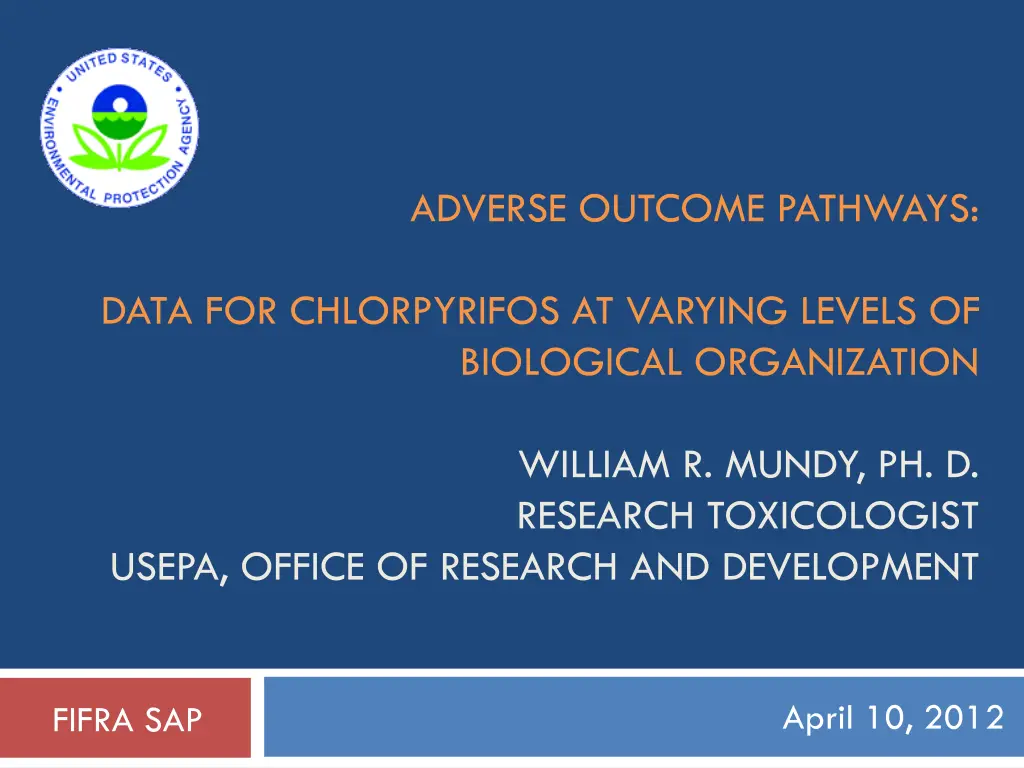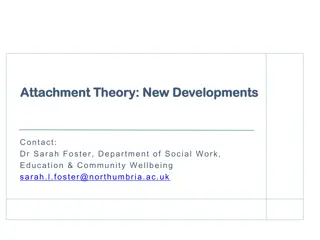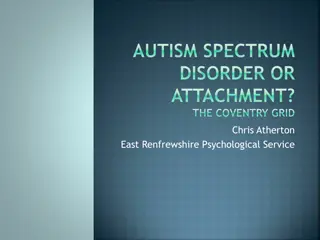
Understanding Adverse Outcome Pathways and Their Importance in Toxicology
Explore the concept of Adverse Outcome Pathways (AOPs) and their significance in evaluating data for substances like chlorpyrifos at varying levels of biological organization. Learn how AOPs depict the link between molecular events and adverse outcomes, providing insights for risk assessment in toxicology studies.
Download Presentation

Please find below an Image/Link to download the presentation.
The content on the website is provided AS IS for your information and personal use only. It may not be sold, licensed, or shared on other websites without obtaining consent from the author. If you encounter any issues during the download, it is possible that the publisher has removed the file from their server.
You are allowed to download the files provided on this website for personal or commercial use, subject to the condition that they are used lawfully. All files are the property of their respective owners.
The content on the website is provided AS IS for your information and personal use only. It may not be sold, licensed, or shared on other websites without obtaining consent from the author.
E N D
Presentation Transcript
ADVERSE OUTCOME PATHWAYS: DATA FOR CHLORPYRIFOS AT VARYING LEVELS OF BIOLOGICAL ORGANIZATION WILLIAM R. MUNDY, PH. D. RESEARCH TOXICOLOGIST USEPA, OFFICE OF RESEARCH AND DEVELOPMENT April 10, 2012 FIFRA SAP
Introduction 2 Adverse Outcome Pathway concept example evaluating data Adverse Outcome Pathways for Chlorpyrifos overview example for neurite outgrowth levels of biological organization relationship to AChE inhibition
Adverse Outcome Pathway 3 An Adverse Outcome Pathway (AOP) is a conceptual framework that portrays existing knowledge concerning the linkage between a direct molecular initiating event and an adverse outcome, at a level of biological organization relevant to risk assessment. (Chemical Safety and Sustainability Research Program, 2011; Ankley et al. 2010, Environ. Toxicol. Chem., 29(3): 730-741.) incorporates the concepts of mechanism of action (detailed understanding of the molecular basis of the toxic effect) and mode of action (set of likely key events that lead to a toxic effect)
Adverse Outcome Pathway 4 Macro-Molecular Interactions Cellular Responses Organ Responses Individual Responses Population Responses Toxicant Receptor/Ligand Interaction Gene Activation Altered Physiology Lethality Chemical Property Profile Structure Protein Production Disrupted Homeostasis Impaired Development DNA Binding Recruitment Altered Signaling Protein Oxidation Altered Tissue Development or Function Impaired Reproduction Extinction Protein Depletion Cancer Initiating Event Adverse Outcome Propose a set of biologically plausible linkages to apical toxicity Place data collected at different levels of organization into context Focus on chemical mechanisms related to adverse outcome
II. Adverse Outcome Pathways definition and example Exposure Uptake-Delivery to Target Tissues Perturbation Cellular response pathway Normal Biological Function Biologic inputs Early cellular changes Adaptive Responses Cell inury, Inability to regulate Adverse Outcomes (e.g., mortality, Reproductive Impairment) Adverse outcome relevant to risk assessment Molecular initiating event Perturbed cellular response pathway Toxicity Pathway Adverse Outcome Pathway Modified From NRC 2007
Adverse Outcome Pathway: Domoic Acid 6 Macro-Molecular Interactions Cellular Responses Organ Responses Individual Responses Toxicant intracellular Ca2+ dysregulation domoic acid (EAA) glutamate (kainate) receptor activation hippocampal cell death memory loss File:Domoinic Acid Structural Formulae.png Key events or predictive relationships spanning levels of biological organization Adverse outcome relevant to risk assessment Molecular initiating event
Adverse Outcome Pathway: evaluation of data 7 Macro-Molecular Interactions Cellular Responses Organ Responses Individual Responses Toxicant intracellular Ca2+ dysregulation domoic acid (EAA) glutamate (kainate) receptor activation hippocampal cell death memory loss File:Domoinic Acid Structural Formulae.png Plausibility: theoretical basis for biological connections Temporal relationship: effects at lower level must precede the next Dose-response: dose for effect at lower level should be the next Experimental verification: altering effect at one level alters the next
Potential Adverse Outcome Pathways for Chlorpyrifos 8 Domain Chemical Macro-Molecular Interactions Cellular Responses Organ Responses Individual Responses AChE as morphogen In Vitro In Vitro In Vivo In Vivo (zebrafish) Cholinergic receptors In Vitro In Vitro Endocannabinoid system In Vitro In Vivo chlorpyrifos, chlorpyrifos oxon, or trichloropyridinol ROS In Vitro In Vivo In Vivo Serotonergic system In Vitro In Vivo In Vivo In Vivo Tubulin, MAPs In Vitro In Vivo In Vitro In Vivo
Potential Adverse Outcome Pathway: Morphogenic site 9 Macro-Molecular Interactions Cellular Responses Organ Responses Individual Responses Toxicant CPF, CPO, TCP Binding to AChE (morph site) Neurite Growth Neural Connectivity Cognition CPF (in vitro, in vivo) CPF-esterase (morph?) decrease in vitro ( AChE inhibition) CPO (in vitro, in vivo) CPO-esterase (morph?) decrease in vivo (+ AChE inhibition) TCP (in vitro) CPO-morph Key events or predictive relationships spanning levels of biological organization Adverse outcome relevant to risk assessment Molecular initiating event
Potential Adverse Outcome Pathways for Chlorpyrifos Domain Chemical Macro- Molecular Interactions Cellular Responses Organ Responses Individual Responses 10 AChE as morphogen morphogenic site of AChE neurite growth axon length Cholinergic receptors M2 receptor cAMP chlorpyrifos, chlorpyrifos oxon, or trichloropyridinol Endocannabin oid system CB1 receptor FAAH ROS oxidative stress oxidative stress response genes Serotonergic system changes in level of serotonin, serotonin turnover, receptors, etc. changes in level of serotonin, serotonin turnover, receptors, etc., by brain region changes in behavior, both basal and after drug challenge Tubulin, MAPs binding to tubulin and MAPs axonal transport Initiating Event
Adverse Outcome Pathways for Chlorpyrifos: Relationship to AChE Inhibition 11 Assessed AChE activity concurrently Concentration/dose-response Significant response in absence of significant AChE inhibition Experimental model Primary neuron culture (in vitro) Response decrease neurite outgrowth Rat (developmental exposure) increase oxidative stress genes in CNS Primary neuron culture (in vitro) inhibition of axonal transport Rat* (developmental exposure) change in serotonergic tone of adult CNS * AChE measured in separate experiment
Summary 12 Plausibility multiple biologically plausible initiating/downstream events few AOPs explicitly outlined/studied Temporal relationship data show temporal relationship between exposure and effect Dose-response limited data across levels of biological organization some evidence of possible effects (neurite outgrowth, binding to muscarinic receptors, axonal transport) which are similarly sensitive or more sensitive than AChE inhibition Experimental verification limited data verifying connection between levels of biological organization
Questions? 13






















